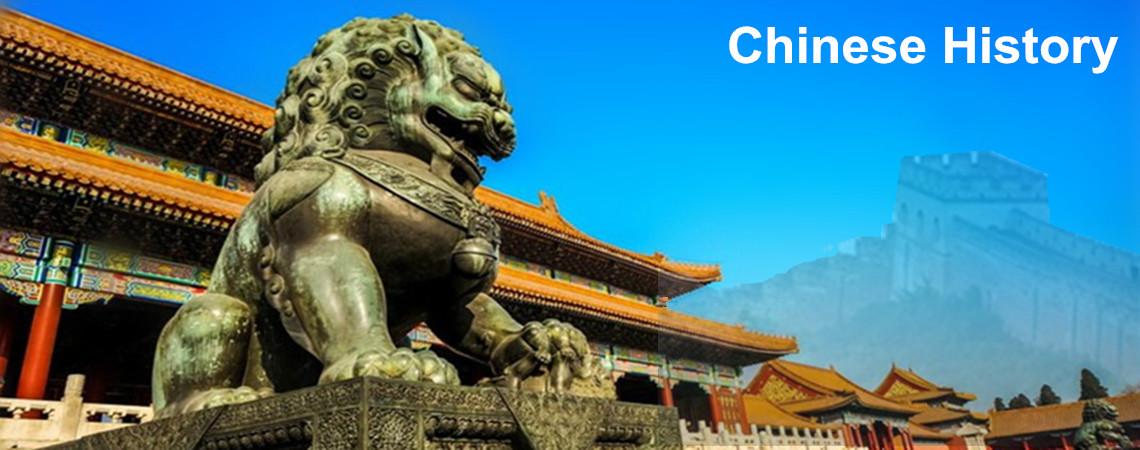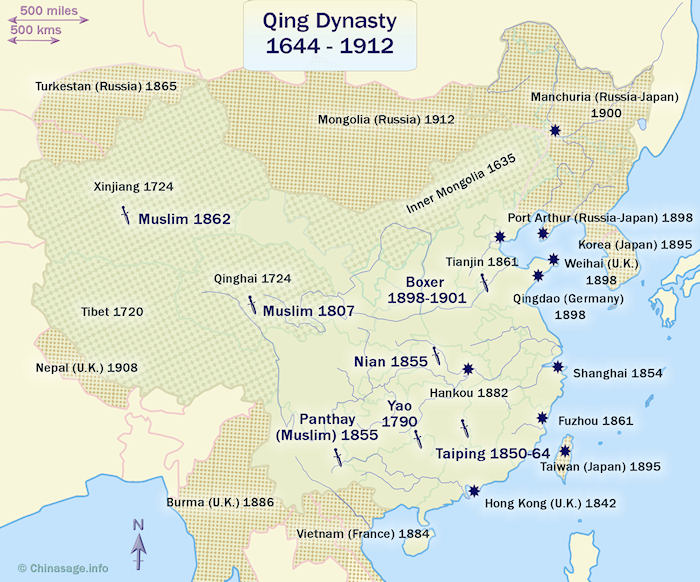
Qing Dynasty (1636-1911)
 Qing Dynasty (1644–1912) was the last and the longest Chinese dynasty ruled by the Manchus from Manchuria, northeast of the Great Wall. Although the Manchus were not Han Chinese and were strongly resisted, especially in the south, they had assimilated a great deal of Chinese culture before conquering China Proper. Realizing that to dominate the empire they would have to do things the Chinese way, the Manchus retained many institutions of Ming and earlier Chinese derivation.
Qing Dynasty (1644–1912) was the last and the longest Chinese dynasty ruled by the Manchus from Manchuria, northeast of the Great Wall. Although the Manchus were not Han Chinese and were strongly resisted, especially in the south, they had assimilated a great deal of Chinese culture before conquering China Proper. Realizing that to dominate the empire they would have to do things the Chinese way, the Manchus retained many institutions of Ming and earlier Chinese derivation. Time: 1636-1911
Location of Capital: Beijing
Emperors: Kangxi, Yongzheng, Qianlong, Jiaqing, Daoguang, Xianfeng, Tongzhi(Cixi), Guangxu, Puyi
Replaced by: Republic of China(1912-1949)
Rise of the Qing Dyansty
Before Qing's establishment, there was a regime called 'Latter Jin' that had been set up by Nurhachu, leader of the Man Ethnic Minority. Actually, Man people were the offspring of the Nuzhen people who had always been living in Northeast China. After reunifying all the Nuzhen tribes, Nurhachu proclaimed himself emperor in 1616. Thus a new regime called Latter Jin was founded in Hetu Ala (in current Liaoning Province) during the reign of Emperor Shenzong of the Ming Dynasty (1368 - 1644).
1. The Regent Dorgon Led the Government (1643-1650)
Dorgon was the regent and ruled on behalf of the child emperor. When Dorgon died in 1650, Emperor Shunzhi started to rule personally when he was 13 until he died at 24 in 1661.
His policies of reappointing the Ming officials helped the empire to stabilize and prosper. The Manchus did not destroy Beijing and decimate the population as was commonly done. Instead, they persuaded Ming officials and military leaders to surrender to them.
2. The Hairstyle Massacre in 1645
In 1646, Dorgon reestablished the imperial examinations, held every three years, and in this way, he gained the support of large numbers of literati and the bureaucracy. A problem in the empire increasingly became the lack of modern education. The empire concentrated on Imperial Examinations, studying ancient philosophical and religious texts.The Qing rulers did little to promote the knowledge of the world. Instead, they were isolationist.
Middle Period of the Qing Dynasty
By the middle of the 18th century, the feudal economy of the Qing Dynasty reached a zenith, spanning the reign of Emperor Kangxi, Emperor Yongzheng and Emperor Qianlong. So that period was usually called 'the golden age of three emperors'.
In that period, both culture and science were much more prosperous than any other periods. The notable book, The Imperial Collection of Four, was edited in that period. Also, a group of scholars and artists such as Cao Xueqin (writer of A Dream of Red Mansions), Wu Jingzi (writer of The Scholars) and Kong Shangren (writer of The Peach Blossom Fan) gradually appeared. In the field of science, the achievements in architecture were outstanding.
Later Period of the Qing Dynasty
After the middle period, all kinds of social contradictions increasingly surfaced and Qing began to decline. Under the corrupt ruling of the later rulers, various rebellions and uprisings broke out. The Westernization Movement, the Reform Movement of 1898 and the Taiping Rebellion were the most influential ones, but none of them had ever succeeded in saving the dying Qing Dynasty.
Emperor Daoguang (Ruled 1821-1851)
The leader of the Taiping Rebellion was Hong Xiuquan. His quasi-Christian movement had some forward-thinking idealswhich the Qing Dynasty disagreed with (he banned slavery, men using concubines, arranged marriages, opium use, foot binding, torture, and the worship of idols, and he wanted women to have more equality in society). He made Nanjing his capital, and his army seemed ready to attack Beijing. However, Britain and France sent troops to aid the Qing army. In 13 years, about 25 million people died.
1. Japanese Took Taiwan and Liaoning (1894–5)
The Japanese modernized remarkably quickly in the latter part of the 19th century, and started to attack the Qing Empire and take territories for colonies. The Qing Dynasty lost the Sino-Japanese War (1894–1895), and the Japanese made Formosa (Taiwan) and Liaoning (the northeast corner of China, i.e. Manchuria, once the Manchu homeland) a part of their empire. Taiwan became an industrial colony.
2. Emperor Guangxu Imprisoned by Cixi (1898)
In 1900, a rebellion started among the poor, led by people who studied martial arts, so it was called the Boxer Rebellion. At first their goal was to overthrow the government and expel or kill foreigners. But Cixi supported the movement secretly, so the leaders supported the Qing Dynasty. The US sent a detachment of troops in the war against the Boxers, and the Qing court was forced to pay war reparations to the US. The US used these funds to build Tsinghua University, now China's top-ranking institution.
4. Ending of the Qing Dynasty
In 1908, when Cixi and the emperor suddenly died, Puyi became "the last emperor" — 2-year-old Emperor Xuantong. The empire's official ruler was a prince regent Zaifeng, Puyi's father. Finally, the Revolution of 1911 led by Sun Yat-sen broke out and overthrew the Empire of Qing, bringing two thousand years of Chinese feudal monarchy to an end.







 Ask Questions ?
Ask Questions ?